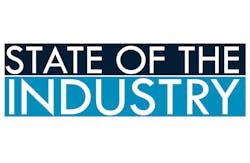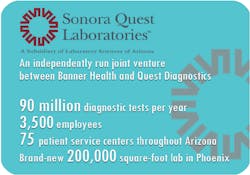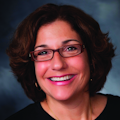The lab – a joint venture between Banner Health and Quest Diagnostics – rolled out its testing program in phases. It launched an in-house molecular test to detect SARS-CoV-2 in March and a serology test to detect the antibodies the body produces in response to the virus in May.
In May it also launched a program with the state of Arizona to test staff and residents at all 147 nursing homes in the state, or the equivalent of about 125,000 tests. Sonora Quest plans to use its mobile diagnostic services, which already service long-term care facilities for routine blood draws, to collect specimens for both the molecular and serology tests. Administrators at the individual facilities will decide whether they want molecular tests, serology tests, or a combination of both.
But getting to this point has not been easy. It involved long hours, creativity, and teamwork.
On the molecular front, there were numerous challenges to overcome.
The lab uses high-throughput analyzers from Roche and Hologic for molecular testing. To meet the expected demand for testing in Arizona, Sonora Quest purchased additional machines from those vendors. Once the machines arrived, staff from both Sonora Quest and the vendors worked to get the machines installed, validated and in production in just days rather than weeks, which is typically the case under normal circumstances.
Then they hustled to find enough test kits, including both the reagents and swabs.
When it became clear that Sonora Quest would not be able to get enough test kits from the manufacturers, the lab sourced the materials separately in bulk. “Volunteers from every functional team came in and met in a warehouse and built kits together,” explained Sonya Engle, chief operating officer at Sonora Quest.
The molecular department also validated alternatives to nasopharyngeal swabs – such as those made of flock and spun polyester – and viral transport media – such as sterile saline.
Training was another significant challenge. With a slow-down in elective procedures and visits to doctor’s offices, Sonora Quest redeployed some employees from other functional departments to molecular testing to accommodate the ramping up process and the 24/7 operation of the high-throughput machines. “The training has to be thorough. Somebody has to be there working the bench and training somebody at the same time. That takes a lot of resources,” said Brian Koeneman, PhD, scientific medical director of molecular diagnostics at Sonora Quest.
In addition to the challenges of sourcing supplies and equipment, there also were challenges for the lab’s information systems (LIS) department to overcome.
For example, Sonora Quest developed a process so it could send out specimens for the molecular tests to Quest facilities in other states when demand exceeded its in-house capacity. And, for the first time, Sonora Quest committed to processing specimens from Quest in other states on days when the reverse was true.
That meant the information systems department at Sonora Quest had to create an electronic interface between its laboratory information system (LIS) and the IT system at Quest Diagnostics.
The IT staff also had to modify its LIS, NeTLIMS, to accommodate new equipment for both molecular and serology testing. The goal was to have testing “flex” behind-the-scenes at Sonora Quest to accommodate the multiple instrument platforms, but keep that process invisible to customers who send in specimens, such as hospitals and doctor’s offices, as well as patients, who are able to order the serology test directly from Sonora Quest without an order from a provider.
“The bigger challenge was because everything was changing so much. We had to do some very creative building on our side with our NeTLIMS partner to make that work,” Jackie Carlisle, director of laboratory information systems at Sonora Quest, said. “I think it has really challenged us to think outside the box and look for solutions that we didn’t even know we could do,” she said.


